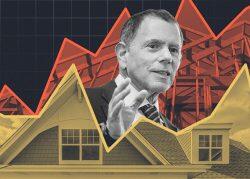The homebuilding fever that accompanied the nationwide market boom broke last year, though home construction in several of the hottest markets still topped 2021 levels.
The pace of growth in the 25 metro areas that built the most housing last year slowed overall, with about 1 percent fewer units built last year than in the year prior. But among the top 10 cities, building increased by more than 5 percent.
In hot markets such as Dallas-Fort Worth — where a pullback in homebuilding began in June — the construction frenzy in the first half of the year was enough for the metro to finish 2022 with more homes finished than in the year before.
Construction hotspots
Texas metros dominated the ranking for housing construction once again in 2022, with Dallas-Fort Worth and the Houston area leading the nation in new housing units. New York, Atlanta and Phoenix rounded out the top five.
Bear in mind that the New York metropolitan area has nearly 19 million people, versus fewer than 8 million in Dallas-Fort Worth.
Austin’s metro area, with a population of just 2.35 million, came in sixth for the number of units built, though its total was about 10 percent below the previous year’s.
Atlanta jumped from No. 6 in 2021 to the fourth spot last year thanks to a nearly 24 percent jump in units built, the largest increase in the nation. No. 9 Tampa saw the second-highest jump, building 21 percent more housing than in the previous year.
Philadelphia and Nashville experienced the sharpest pullbacks in residential building among the top 25 metros for housing production, with new construction dropping 43 percent and 36 percent, respectively.
Supply and demand
The nation ended 2022 with an estimated 941,320 homes for sale. That was up nearly 7.5 percent from December 2021, but more than 32 percent below the end-of-2019 total.
Among the top five metro areas, Chicago saw the biggest drop in inventory — more than 36 percent — between the end of January 2020 and the end of December 2022, followed closely by New York City, where inventory shrank by nearly 36 percent. Los Angeles had the smallest drop, at just over 17 percent.
On the demand side, national home-price data show that 2021 was the peak of the now-deflating homebuying boom.
Over the course of 2020, the Zillow Home Value Index went up by just over 9 percent. During 2021 it shot up by nearly 20 percent. But in 2022, as the Federal Reserve hiked interest rates, price growth returned to 2020 levels.
Taken together, the three strong years pushed the home value index to $357,319 at the end of 2022, nearly 43 percent higher than it was at the start of 2020.
This is one of the hundreds of data sets available on TRD Pro (therealdeal.com/pro/about) — the one-stop real estate terminal for all the data and market information you need.
Read more



